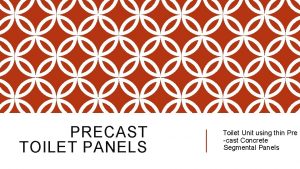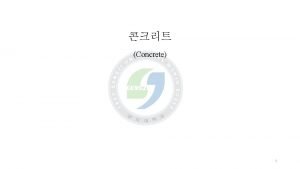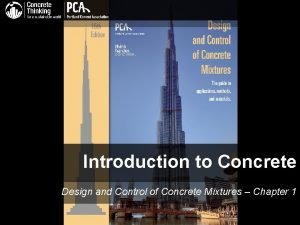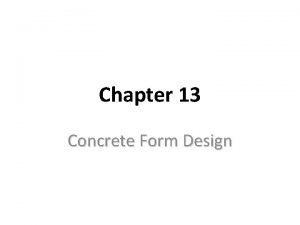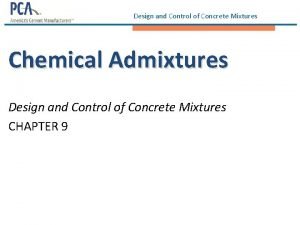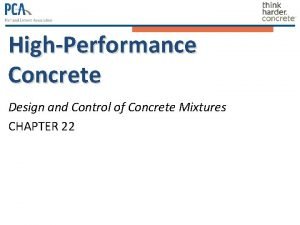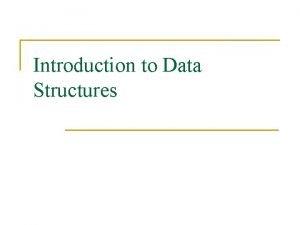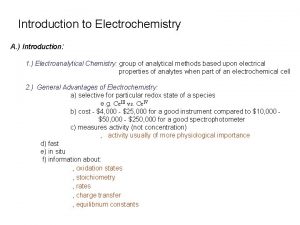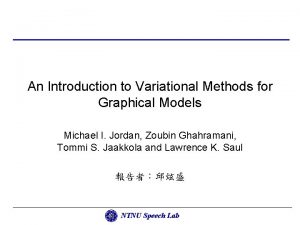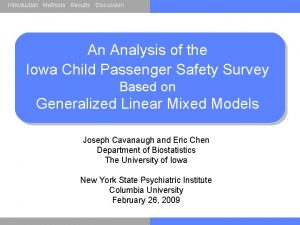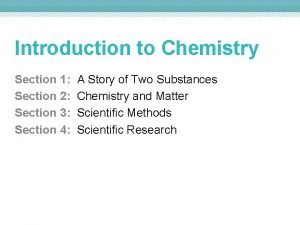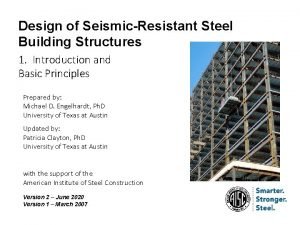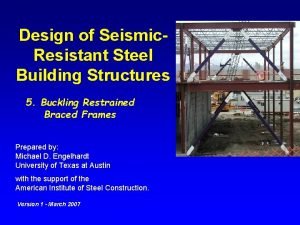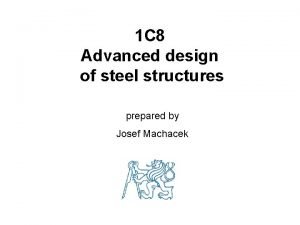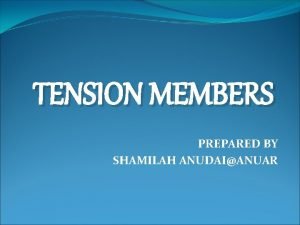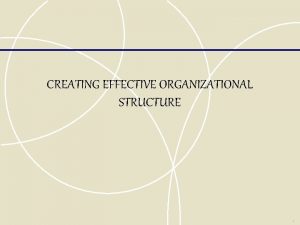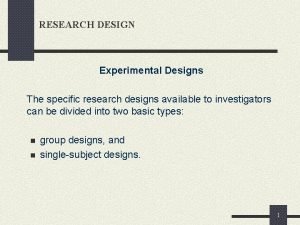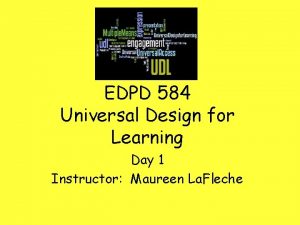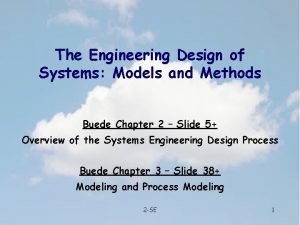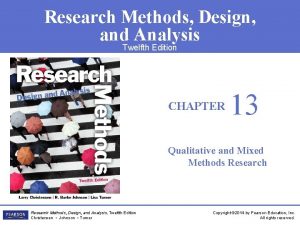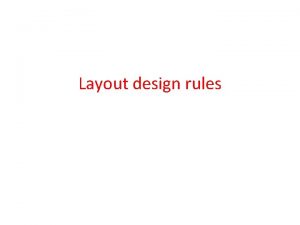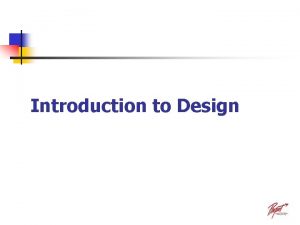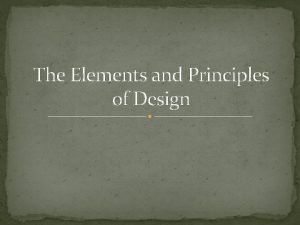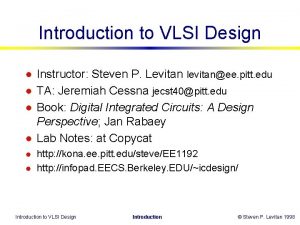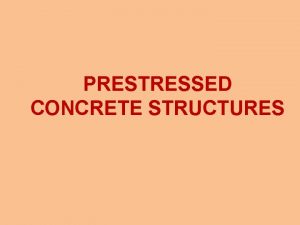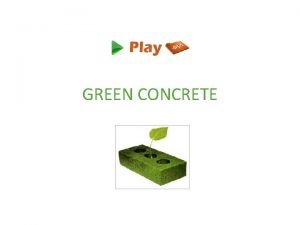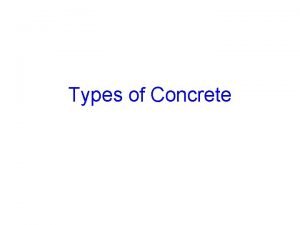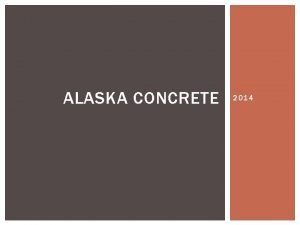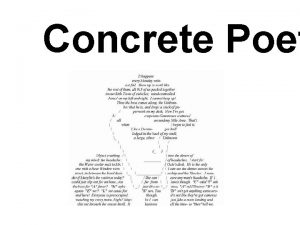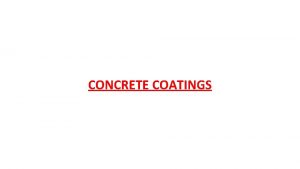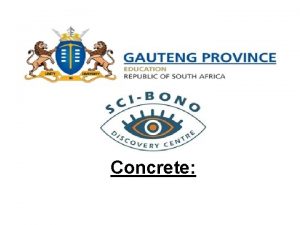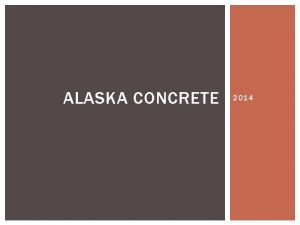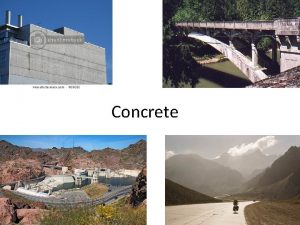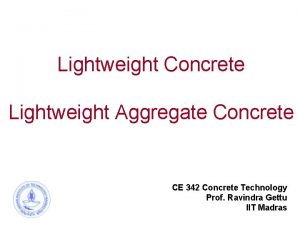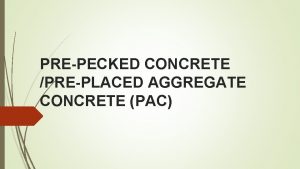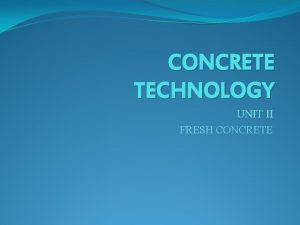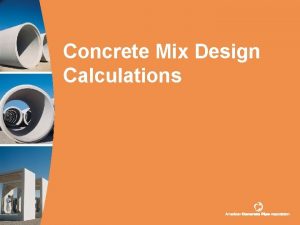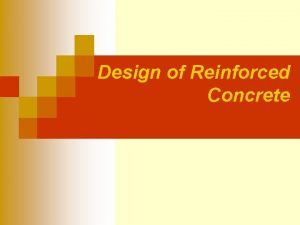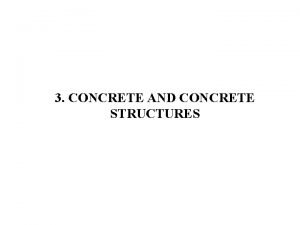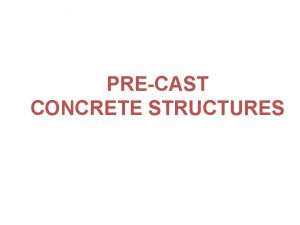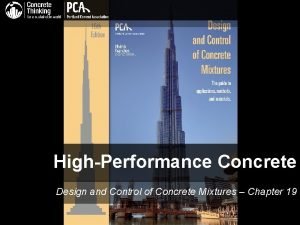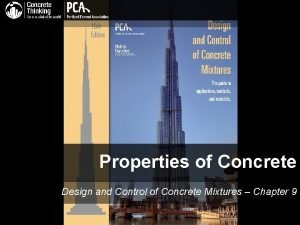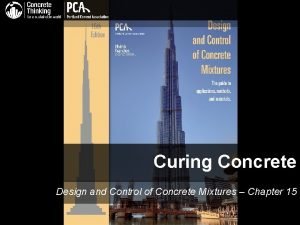Concrete Structures l l Introduction to design methods









































- Slides: 41

Concrete Structures l l Introduction to design methods in reinforced concrete Sustainable construction – is concrete “green”? Possibilities in concrete structure Technical concepts: - Bending moment diagrams Reinforced vs. prestressed concrete Strut and tie method of design

Outline l Introduction to concrete as a material l Stresses in bending l Reinforced concrete vs. prestressed concrete l Design methods l Environmental issues l Design possibilities l Conclusions

Unreinforced Concrete l Same as masonry: it must act in compression (no resistance to tension) - Roman Pantheon, 126 AD

Beginnings of Reinforced Concrete

Bending Stresses in a Beam

Steel Reinforcing in Concrete

Design Basis for Reinforced Concrete

Reinforced vs. Prestressed Concrete

Principles of Reinforcing

Two design methods for concrete o Conventional design: - o Determine moment diagram Specify steel in areas of tension Strut and tie models: - - Define internal forces in tension and compression (ties and struts) Specify steel in areas of tension

Strut and Tie Modeling

Strut and Tie Modeling

Strut and Tie Modeling

Strut and Tie Modeling

What is concrete?

Is concrete a green material?

Construction and the Environment In the United States, buildings account for: 36% of total energy use (65% of electricity consumption) 30% of greenhouse gas emissions 30% of raw materials use 30% of waste output (136 million tons/year) 12% of potable water consumption -US Green Building Council (2001)

Construction Waste l US Environmental Protection Agency (EPA) estimates that 136 million tons of waste is generated by construction each year l Most results from demolition/renovation and nearly half the weight is concrete

Embodied Energy per Stiffness

Energy required for concrete


Corrosion of Reinforced Concrete

Reinforced Concrete Corrosion

Corrosion of RC l In the United States, the overall costs of reinforcing steel corrosion have been estimated at more than $150 billion per year. l A particular problem for highway bridges due to de-icing salts

Corrosion Prevention of RC o o Simplest method: Maintain concrete in compression and provide greater cover of concrete over rebar More complicated and more expensive: - - Protect steel (with epoxy coating) or by using stainless steel rebar Use non-metallic reinforcing, such as carbon or kevlar, but these materials are expensive and energy-intensive

Structural Design in RC l l l Maintain concrete in compression as much as possible Follow moment diagram to minimize material use Detailed design - Prevent water infiltration Protect steel Specify use of fly ash Recycle old concrete

“Fly Ash” in Concrete l Fly ash is a byproduct of coal burning: 600 million tons are produced per year and over 80% goes to the landfill l Up to 50% of cement (by volume) can be replaced with fly ash (15 -35% is typical) l Today only about 10% of available fly ashis used in concrete

Why use fly ash in concrete? l Reduce environmental impact l Improve workability (better finish) l Increase corrosion resistance l Improve long term concrete strength

Good practice in concrete design l l Consider pre-cast concrete systems which can use considerably less concrete. Specify fly ash, which can improve workability and strength, as well as help to recycle waste. Use concrete waste as fill whenever possible around buildings or as aggregate under parking lots and driveways. Reduce waste through design by eliminating unnecessary concrete (i. e. use smaller transfer beams in the Stata Center)

Precast Planks in Concrete

Tilt-Up Concrete Construction

Hanging Model by Heinz Isler

Tension Model by Heinz Isler

Compression Model by Heinz Isler

Post-tensioned Box Grider

Greater Depth Gives Greater Stiffness

Conclusions l l l Concrete will continue to be a dominant construction material Reinforced concrete must crack in order for reinforcing to work → lower durability because steel can corrode Prestressed concrete prevents cracking Two powerful design methods: moment diagrams or strut and tie models Environmental impact can be reduced through design


Ecological Profile of Materials

Material Properties

Material Properties
 Informal inventory
Informal inventory Concrete semi concrete abstract
Concrete semi concrete abstract Precast concrete toilet structures
Precast concrete toilet structures How are the whale flipper and the human arm different
How are the whale flipper and the human arm different Inlay wax pattern fabrication
Inlay wax pattern fabrication Plastic state of concrete
Plastic state of concrete Introduction of concrete
Introduction of concrete Red fort
Red fort Concrete form design
Concrete form design River bank
River bank Design and control of concrete mixtures
Design and control of concrete mixtures Density of concrete
Density of concrete Introduction to data structures
Introduction to data structures Introduction to data structures
Introduction to data structures Introduction of electrochemistry
Introduction of electrochemistry An introduction to variational methods for graphical models
An introduction to variational methods for graphical models Introduction method result and discussion
Introduction method result and discussion Introduction to chemistry section 3 scientific methods
Introduction to chemistry section 3 scientific methods Design of seismic-resistant steel building structures
Design of seismic-resistant steel building structures Design of seismic-resistant steel building structures
Design of seismic-resistant steel building structures Advanced design of steel structures notes
Advanced design of steel structures notes Tension members
Tension members Organizational design traditional structures
Organizational design traditional structures Fact-finding techniques in system analysis and design
Fact-finding techniques in system analysis and design Research design example
Research design example Universal design methods
Universal design methods What is form control in system analysis and design
What is form control in system analysis and design Breakdown method in sales
Breakdown method in sales Bmi504
Bmi504 Convergent design mixed methods
Convergent design mixed methods The engineering design of systems: models and methods
The engineering design of systems: models and methods Research methods design and analysis
Research methods design and analysis Methods of exploratory research design
Methods of exploratory research design Introduction paragraph structure
Introduction paragraph structure Introduction to system analysis and design
Introduction to system analysis and design Lambda based design rules
Lambda based design rules Introduction to interior design
Introduction to interior design An introduction to design science
An introduction to design science Design of introduction
Design of introduction Introduction to elements of design
Introduction to elements of design Introduction to vlsi design
Introduction to vlsi design Vertical
Vertical


